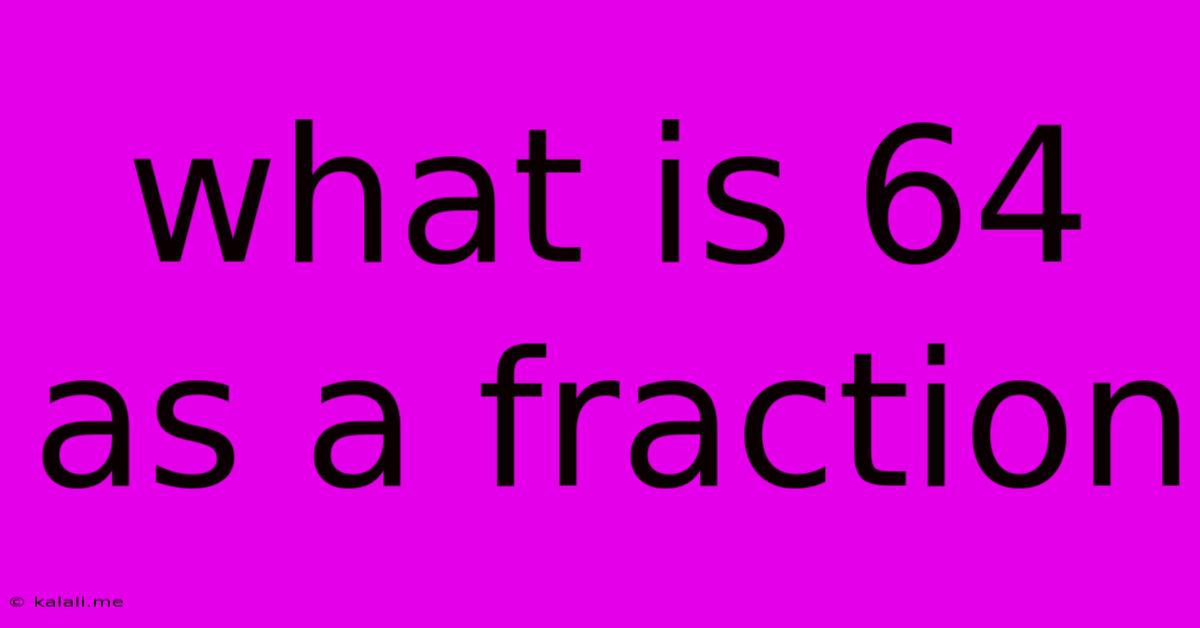What Is 64 As A Fraction
Kalali
May 09, 2025 · 2 min read

Table of Contents
What is 64 as a Fraction? Understanding Whole Numbers as Fractions
The question "What is 64 as a fraction?" might seem deceptively simple. After all, 64 is a whole number, not a fraction, right? But understanding how to represent whole numbers as fractions is a fundamental concept in mathematics, crucial for various calculations and applications. This article will delve into the process, exploring different approaches and highlighting its importance.
Understanding Fractions and Whole Numbers
A fraction represents a part of a whole. It's expressed as a ratio of two numbers: the numerator (top number) and the denominator (bottom number). The denominator indicates how many equal parts the whole is divided into, while the numerator shows how many of those parts are being considered. For example, 1/2 represents one of two equal parts.
Whole numbers, on the other hand, represent complete units without any fractional components. 64, for instance, represents 64 complete units.
Expressing 64 as a Fraction
To express 64 as a fraction, we need to remember that any whole number can be written as a fraction with a denominator of 1. This is because dividing any number by 1 results in the same number. Therefore:
64 = 64/1
This is the simplest and most common way to represent 64 as a fraction. It clearly shows that we have 64 complete units (numerator) out of a possible 1 unit (denominator).
Other Equivalent Fractions
While 64/1 is the simplest form, it's important to note that there are infinitely many equivalent fractions representing 64. An equivalent fraction has the same value as the original fraction, but its numerator and denominator are different. We can obtain equivalent fractions by multiplying both the numerator and the denominator by the same number. For example:
- 64/1 * 2/2 = 128/2
- 64/1 * 3/3 = 192/3
- 64/1 * 10/10 = 640/10
All these fractions are equivalent to 64/1 and represent the same value – 64. However, 64/1 remains the simplest and most preferred representation.
Why is this Important?
Understanding how to represent whole numbers as fractions is critical for:
- Adding and Subtracting Fractions: When working with fractions and whole numbers together, it’s necessary to express whole numbers as fractions to perform arithmetic operations.
- Solving Equations: Many mathematical equations involve fractions, and the ability to represent whole numbers as fractions is vital for solving them.
- Understanding Ratios and Proportions: Ratios and proportions are expressed using fractions, and converting whole numbers into fractions helps in understanding and solving problems related to them.
- Working with Decimals: Fractions and decimals are closely related. Understanding how to represent whole numbers as fractions provides a solid foundation for working with decimals.
In conclusion, while 64 might seem straightforward as a whole number, expressing it as the fraction 64/1 provides a powerful and versatile representation that unlocks more advanced mathematical operations and problem-solving capabilities. Understanding this basic concept lays a solid foundation for more complex fractional calculations.
Latest Posts
Latest Posts
-
How Does The Monster Try To Gain Control Of Victor
Jul 14, 2025
-
Why Did The Cow Want A Divorce
Jul 14, 2025
-
Lowest Common Denominator For 3 4 5
Jul 14, 2025
-
Can You Be A Professor With A Masters
Jul 14, 2025
-
How Many Bottles Of Water Is 1 Liter
Jul 14, 2025
Related Post
Thank you for visiting our website which covers about What Is 64 As A Fraction . We hope the information provided has been useful to you. Feel free to contact us if you have any questions or need further assistance. See you next time and don't miss to bookmark.